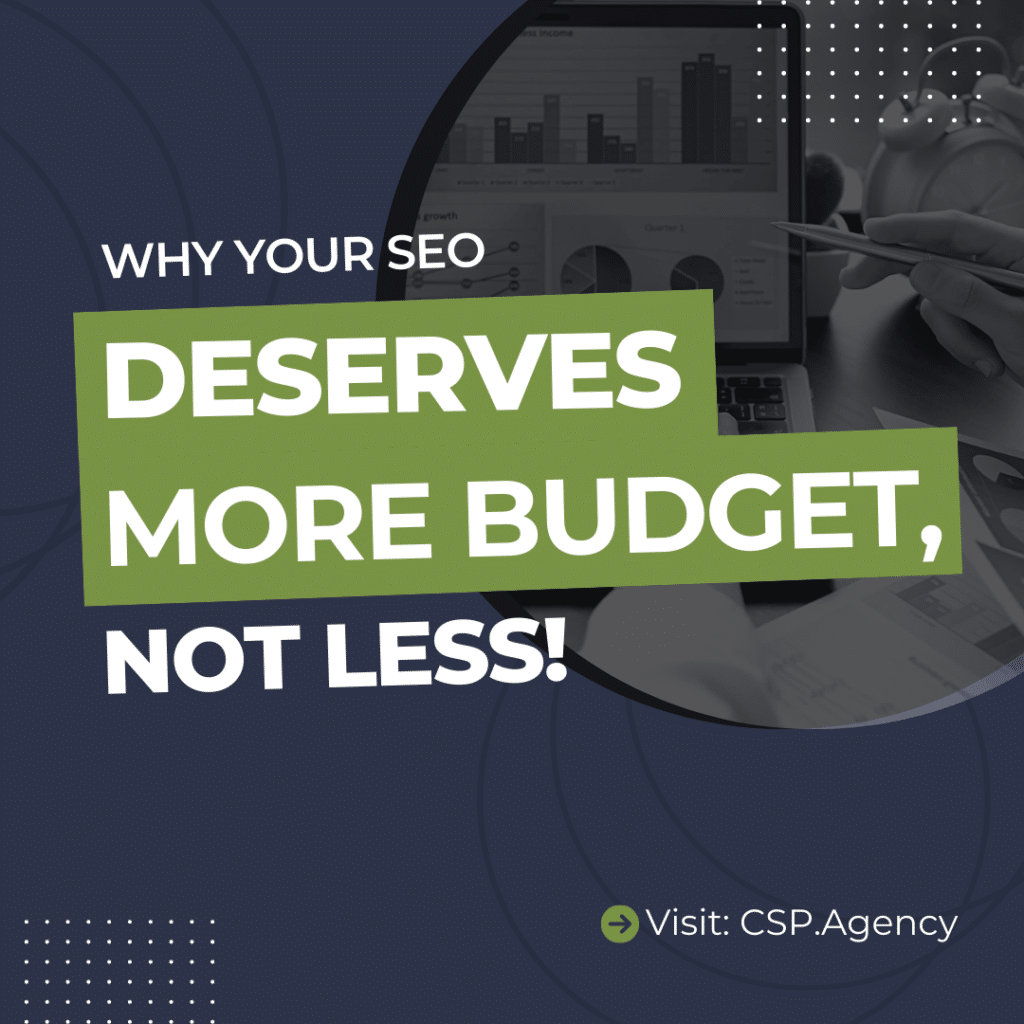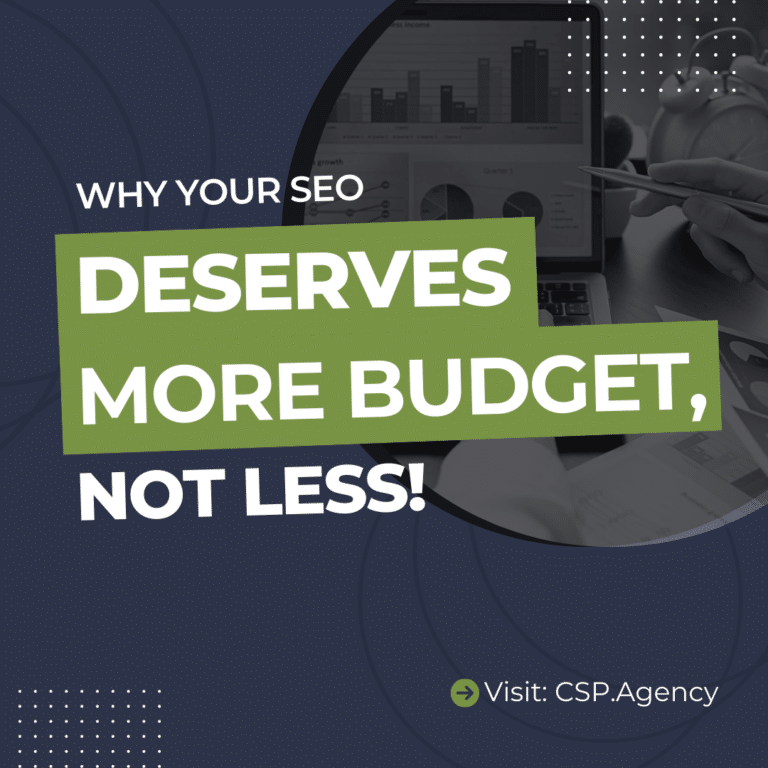Getting leadership to see the value of SEO depends on your ability to convey its Return on Investment (ROI) potential and how it contributes to your brand’s broader marketing initiatives: driving traffic and conversions, brand awareness, low-cost lead generation, and measurable results that pave the way for continual optimization.
Marketing with a tight budget limits your SEO potential, so being able to lobby for larger SEO budgets persuasively is an essential skill. Suppose you can educate higher-ups and point to tangible impacts you’re already making. In that case, you can convince them to earmark more money for SEO strategy development and exponentially grow your visibility, traffic, and conversions.
How SEO Brings People To Your Site
SEO brings people to your site by ensuring your web pages show up when your target audience searches for keywords you’ve optimized your site for. Since 75% of users never click past page one of search results, only the top-ranking pages will gobble up meaningful traffic from a given search. The top three results get 54.4% of all clicks!
Your brand’s website is like your baby—to you, it’s the most amazing thing in the world, but the only way to get others on the same page is to shove those baby photos in their faces (or get your site in front of them on SERPs). People need to be led to your website and SEO is the most cost-effective way to lead them there.
Is It Really Necessary to Do SEO?
It’s more important than ever to prioritize SEO. It’s responsible for driving over 50% of all organic traffic and providing the highest ROI value, with 29% of marketers saying it’s their best ROI channel and high-quality campaigns seeing as much as 748% ROI.
This cost-effective channel enables you to:
- Target users in every stage of the sales funnel
- Capture an average of 40% of conversion-ready organic traffic
- Close 14.6% of leads with SEO vs. 1.7% average for outbound leads
Do big brands need SEO? Big brands aren’t immune to losing traffic to smaller companies that know how to prioritize SEO. When over 63% of all web traffic comes from Google, enterprise SEO strategies are essential to achieve or maintain dominance in search results and drive meaningful traffic, clicks, and conversions.
It’s not just content and fairy dust. It’s the top-performing inbound lead source for 60% of marketers and generates twice the B2B revenue of any other marketing channel. Tuck that tidbit away when you’re preparing to ask leadership for bigger SEO budgets!
SEO: Playing a Larger Role in Your Overall Marketing Plan
While SEO can contribute significantly to sales and clicks, it also plays a larger role in your marketing plan overall. If you’re wondering, “Why am I not seeing returns from SEO in the first month?” Know that only 5.7% of pages achieve top-10 rank within a year of publication and the average page ranking in the top 10 is over 2 years old. On average, it takes just over 3 months to see effects on rank from SEO practices like link building.
It’s a long-term marketing strategy, but it offers enduring, cost-effective results that continue to boost website traffic, brand awareness, and conversions as long as each web page ranks well. When you’re pressured to show tangible results from your SEO efforts, it’s important to know what to report beyond clicks and sales and how to package it persuasively to get a larger SEO budget.
Soft KPIs
Soft Key Performance Indicators (KPIs) are your secret weapon in budget talks when your SEO program is still in its early stages. You may not be able to point to hard KPIs just yet (like conversions, revenue, and clicks), but even early SEO efforts make an impact on soft KPIs.
Personas
SEO personas represent groups of internet users who visit your website after searching for specific keywords. SEO personas are useful in your overall marketing strategy—email, paid search, display ads, and more—because they draw a picture of your target audience’s needs and intent, allowing you to optimize your strategies to better reach and convert these users.
You wouldn’t buy a stranger a gift and expect them to like it, and you can’t effectively target your audience with SEO, email, paid search, or display ads without SEO personas. You’ll know who’s biting the hook you’re setting and learn better ways to bait the hook for continued digital marketing success—two important metrics to bring up in SEO budget talks.
Impressions
Eyeballs lead to clicks and get users moving through your sales funnel. Measuring impressions and click-through-rates (CTRs, or the ratio of clicks to impressions) helps you demonstrate the value of your current SEO efforts and show how those metrics could impact the bottom line with a larger budget.
The average #1 result on Google sees a CTR of 9.28%; #2 averages 5.82%, while #3 achieves 3.11%. Ranking at the top (often requiring a larger SEO budget) is a must to get more impressions, clicks, and eventually, conversions. The more impressions your site gets, the more clicks you’ll see. You need traffic from SEO to see conversions that impact the bottom line, so it all links together in an effective digital strategy.
Channel Attribution
Your site may get organic search, paid search, display ad, and social media traffic referrals, but being able to measure organic search traffic that eventually converts or achieves a desired outcome can be persuasive in budget negotiations. First-click attribution can show how many people first encounter your brand through organic searches, then later go on to convert. You don’t climb a mountain in a straight line—users typically have multiple touches before converting, but channel attribution lets you highlight how SEO is impacting the bottom line.
How can I attribute my leads and sales? Find out which leads and sales come from SEO efforts with attribution modeling on lead tracking platforms and software, like Google Analytics 4 or Hubspot. With the right configuration, you can track where each lead comes from and showcase how many arrive from organic search.
How to Educate Higher-Ups on SEO
Lobbying for a larger budget depends on your ability to educate higher-ups on the value of SEO and how your current budget is putting constraints on your brand’s performance potential. Share wins, small and large, regularly to keep SEO top of mind and highlight its effectiveness.
Here are some convincing SEO statistics to share with leadership:
- 70% of marketers say SEO results in more sales than PPC campaigns
- SEO drives 1,000% more traffic than social media
- 82.5% of marketers plan to increase SEO budgets in 2024
Rely on those soft KPIs above, share enlightening statistics, and make sure you’re properly attributing leads and conversions to organic search to strengthen your case. It can be slow-going at first, but SEO creates its own momentum when you have the right strategy. Done properly, SEO plays off other marketing channels to support a comprehensive plan that works synergistically.
Need help steering your brand toward higher rankings to make the most of your SEO budget—or deliver big wins that convince your bosses it’s time to increase spending? Get advice from an SEO expert today.


